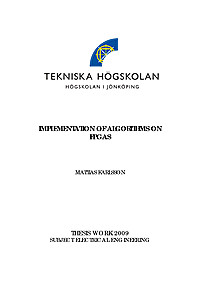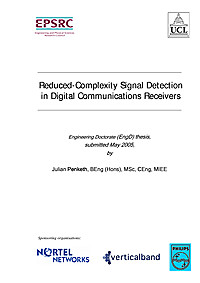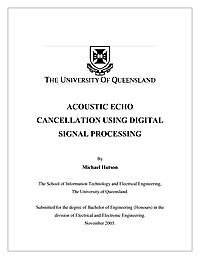
Implementation of Algorithms on FPGAs
This thesis describes how an algorithm is transferred from a digital signal processor to an embedded microprocessor in an FPGA using C to hardware program from Altera. Saab Avitronics develops the secondary high lift control system for the Boeing 787 aircraft. The high lift system consists of electric motors controlling the trailing edge wing flaps and the leading edge wing slats. The high lift motors manage to control the Boeing 787 aircraft with full power even if half of each motor’s stators are damaged. The motor is a PMDC brushless motor which is controlled by an advanced algorithm. The algorithm needs to be calculated by a fast special digital signal processor. In this thesis I have tested if the algorithm can be transferred to an FPGA and still manage the time and safety demands. This was done by transferring an already working algorithm from the digital signal processor to an FPGA. The idea was to put the algorithm in an embedded NIOS II microprocessor and speed up the bottlenecks with Altera’s C to hardware program. The study shows that the C-code needs to be optimized for C to hardware to manage the up speeding part, as the tests showed that the calculation time for the algorithm actually became longer with C to hardware. This thesis also shows that it is highly probable to use an FPGA equipped with Altera’s NIOS II safety critical microprocessor instead of a digital signal processor to control the electrical high lift motors in the Boeing 787 aircraft.

EngD thesis: Reduced-Complexity Signal Detection in Digital Communications Receivers
The Author began this Engineering Doctorate (EngD) in Autumn 1999, whilst already in full-time employment as a DSP software engineer at Nortel Networks, Harlow. This EngD comprises a set of three projects. The first project was focused on the development of dual-tone multi-frequency (DTMF) signal detection software. DTMF signals are currently used for operating menu-driven services such as voice-mail, telephone banking and share-dealing. The need for detection software in a packet networking environment exists because such signals become degraded when they travel through speech compression circuits. In addition, if they appear as echoes on a telephone line, they can affect the operation of echo cancellation systems. In this thesis a number of DSP algorithms are discussed where fast detection and minimum complexity are key characteristics. A key contribution here was the development of a novel detection algorithm based on the extraction of parameters that model the DTMF signal. The thesis reports a method combining parameter extraction with the technique of maximum likelihood to perform DTMF detection, resulting in very short time-frames when compared to standard approaches. Reducing the complexity of detection techniques is also important in today’s communication systems. To this end a key contribution here was the development of the ‘split Goertzel algorithm’, which permitted an overlapping of analysis windows without the need for reprocessing input data. Besides being applied to voice-band signals, such as in the case of DTMF, the Author also had the opportunity during the EngD to apply the skills and knowledge acquired in signal processing to higher-rate data-streams. This involved work concerning the equalisation of channel distortion commonly found in wireless communication systems. This covers two projects, with the first being conducted at Verticalband Ltd. (now no longer operational) in the area of digital television receivers. In this part of the thesis a real-time DSP implementation is discussed for enhancing a simulation system developed for wireless channels. A number of channel equalisation approaches are studied. The work concludes that for high-rate signals, non-linear algorithms have the best error rate performance. On the basis of the studies carried out, the thesis considers development and implementation issues of designs based on the decision feedback equaliser. The thesis reports on a software design which applies the method of least squares to carry out filter coefficient adaptation. The Verticalband studies reported lead on to further research within the context of channel equalisation, in the context of the detection of data in multiple-input multiple-output (MIMO) wireless local area network (WLAN) systems. This work was undertaken at Philips Research in Eindhoven, The Netherlands. The thesis discusses implementation scenarios of multi-element antenna arrays that aim to provide bit-rates orders of magnitude higher than today’s WLAN offerings, as those required by emerging standards such as 802.11n. The complexity of optimal detection techniques, such as maximum likelihood, scales exponentially with the number of transmit antennas. This translates to high processing costs and power consumption, rendering such techniques unsuitable for use in battery-powered devices. The initial main contribution here was the analysis of the complexity of algorithms whose performance had already been tested, such as the non-linear maximum likelihood approach and also less complex methods utilising linear filtering. This resulted in the development of new formulae to predict processing costs of algorithms based on the number of transmit and receive antennas. Other key contributions were defining a method to reduce the complexity of matrix inversion when using the Moore-Penrose pseudo-inverse, and the application of matrix decomposition to obviate the need for costly matrix inversion at all. Some on-going research into sub-optimal detection is also discussed, which describes methods to reduce the search-space for the maximum likelihood algorithm.

Acoustic Echo Cancellation using Digital Signal Processing
Acoustic echo cancellation is a common occurrence in todays telecommunication systems. It occurs when an audio source and sink operate in full duplex mode, an example of this is a hands-free loudspeaker telephone. In this situation the received signal is output through the telephone loudspeaker (audio source), this audio signal is then reverberated through the physical environment and picked up by the systems microphone (audio sink). The effect is the return to the distant user of time delayed and attenuated images of their original speech signal. The signal interference caused by acoustic echo is distracting to both users and causes a reduction in the quality of the communication. This thesis focuses on the use of adaptive filtering techniques to reduce this unwanted echo, thus increasing communication quality. Adaptive filters are a class of filters that iteratively alter their parameters in order to minimise a function of the difference between a desired target output and their output. In the case of acoustic echo in telecommunications, the optimal output is an echoed signal that accurately emulates the unwanted echo signal. This is then used to negate the echo in the return signal. The better the adaptive filter emulates this echo, the more successful the cancellation will be. This thesis examines various techniques and algorithms of adaptive filtering, employing discrete signal processing in MATLAB. Also a real-time implementation of an adaptive echo cancellation system has been developed using the Texas Instruments TMS320C6711 DSP development kit.

Acoustic Echo Cancellation using Digital Signal Processing
Acoustic echo cancellation is a common occurrence in todays telecommunication systems. It occurs when an audio source and sink operate in full duplex mode, an example of this is a hands-free loudspeaker telephone. In this situation the received signal is output through the telephone loudspeaker (audio source), this audio signal is then reverberated through the physical environment and picked up by the systems microphone (audio sink). The effect is the return to the distant user of time delayed and attenuated images of their original speech signal. The signal interference caused by acoustic echo is distracting to both users and causes a reduction in the quality of the communication. This thesis focuses on the use of adaptive filtering techniques to reduce this unwanted echo, thus increasing communication quality. Adaptive filters are a class of filters that iteratively alter their parameters in order to minimise a function of the difference between a desired target output and their output. In the case of acoustic echo in telecommunications, the optimal output is an echoed signal that accurately emulates the unwanted echo signal. This is then used to negate the echo in the return signal. The better the adaptive filter emulates this echo, the more successful the cancellation will be. This thesis examines various techniques and algorithms of adaptive filtering, employing discrete signal processing in MATLAB. Also a real-time implementation of an adaptive echo cancellation system has been developed using the Texas Instruments TMS320C6711 DSP development kit.

EngD thesis: Reduced-Complexity Signal Detection in Digital Communications Receivers
The Author began this Engineering Doctorate (EngD) in Autumn 1999, whilst already in full-time employment as a DSP software engineer at Nortel Networks, Harlow. This EngD comprises a set of three projects. The first project was focused on the development of dual-tone multi-frequency (DTMF) signal detection software. DTMF signals are currently used for operating menu-driven services such as voice-mail, telephone banking and share-dealing. The need for detection software in a packet networking environment exists because such signals become degraded when they travel through speech compression circuits. In addition, if they appear as echoes on a telephone line, they can affect the operation of echo cancellation systems. In this thesis a number of DSP algorithms are discussed where fast detection and minimum complexity are key characteristics. A key contribution here was the development of a novel detection algorithm based on the extraction of parameters that model the DTMF signal. The thesis reports a method combining parameter extraction with the technique of maximum likelihood to perform DTMF detection, resulting in very short time-frames when compared to standard approaches. Reducing the complexity of detection techniques is also important in today’s communication systems. To this end a key contribution here was the development of the ‘split Goertzel algorithm’, which permitted an overlapping of analysis windows without the need for reprocessing input data. Besides being applied to voice-band signals, such as in the case of DTMF, the Author also had the opportunity during the EngD to apply the skills and knowledge acquired in signal processing to higher-rate data-streams. This involved work concerning the equalisation of channel distortion commonly found in wireless communication systems. This covers two projects, with the first being conducted at Verticalband Ltd. (now no longer operational) in the area of digital television receivers. In this part of the thesis a real-time DSP implementation is discussed for enhancing a simulation system developed for wireless channels. A number of channel equalisation approaches are studied. The work concludes that for high-rate signals, non-linear algorithms have the best error rate performance. On the basis of the studies carried out, the thesis considers development and implementation issues of designs based on the decision feedback equaliser. The thesis reports on a software design which applies the method of least squares to carry out filter coefficient adaptation. The Verticalband studies reported lead on to further research within the context of channel equalisation, in the context of the detection of data in multiple-input multiple-output (MIMO) wireless local area network (WLAN) systems. This work was undertaken at Philips Research in Eindhoven, The Netherlands. The thesis discusses implementation scenarios of multi-element antenna arrays that aim to provide bit-rates orders of magnitude higher than today’s WLAN offerings, as those required by emerging standards such as 802.11n. The complexity of optimal detection techniques, such as maximum likelihood, scales exponentially with the number of transmit antennas. This translates to high processing costs and power consumption, rendering such techniques unsuitable for use in battery-powered devices. The initial main contribution here was the analysis of the complexity of algorithms whose performance had already been tested, such as the non-linear maximum likelihood approach and also less complex methods utilising linear filtering. This resulted in the development of new formulae to predict processing costs of algorithms based on the number of transmit and receive antennas. Other key contributions were defining a method to reduce the complexity of matrix inversion when using the Moore-Penrose pseudo-inverse, and the application of matrix decomposition to obviate the need for costly matrix inversion at all. Some on-going research into sub-optimal detection is also discussed, which describes methods to reduce the search-space for the maximum likelihood algorithm.

Implementation of Algorithms on FPGAs
This thesis describes how an algorithm is transferred from a digital signal processor to an embedded microprocessor in an FPGA using C to hardware program from Altera. Saab Avitronics develops the secondary high lift control system for the Boeing 787 aircraft. The high lift system consists of electric motors controlling the trailing edge wing flaps and the leading edge wing slats. The high lift motors manage to control the Boeing 787 aircraft with full power even if half of each motor’s stators are damaged. The motor is a PMDC brushless motor which is controlled by an advanced algorithm. The algorithm needs to be calculated by a fast special digital signal processor. In this thesis I have tested if the algorithm can be transferred to an FPGA and still manage the time and safety demands. This was done by transferring an already working algorithm from the digital signal processor to an FPGA. The idea was to put the algorithm in an embedded NIOS II microprocessor and speed up the bottlenecks with Altera’s C to hardware program. The study shows that the C-code needs to be optimized for C to hardware to manage the up speeding part, as the tests showed that the calculation time for the algorithm actually became longer with C to hardware. This thesis also shows that it is highly probable to use an FPGA equipped with Altera’s NIOS II safety critical microprocessor instead of a digital signal processor to control the electrical high lift motors in the Boeing 787 aircraft.



















